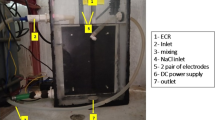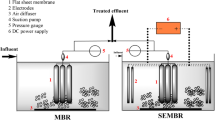Abstract
The aim of this work was to compare the performance between a batch bulk liquid membrane (BBLM) and a continuous bulk liquid membrane (CBLM) in the removal and recovery of Cu(II) ions from wastewater. Effects of operating parameters affecting the resistance of Cu(II) ion transfer such as stirring speeds of phases in BBLM, flow rates of phases through CBLM and operating temperature of both BBLM and CBLM on the removal and recovery of Cu(II) ions from aqueous solutions were explored. The variations in Reynolds number and thickness of boundary layer of all phases with stirring speed in BBLM and with flow rate in CBLM, as well as changes in the viscosity of membrane phase with temperature in both BBLM and CBLM were also investigated. A comparison of performance between BBLM and CBLM in the treatment of real industrial wastewater was also conducted and evaluated. It was found that BBLM achieved higher extraction (removal) and stripping (recovery) of Cu(II) ions of up to 16% than CBLM over the range of experimental conditions studied. Both BBLM and CBLM were found to remove and recover Cu(II) ions effectively from real industrial wastewater.








Similar content being viewed by others
References
Ameur, H. (2016). Mixing of complex fluids with flat and pitched bladed impellers: effect of blade attack angle and shear-thinning behaviour. Food and Bioproducts Processing, 99, 71–77.
Bhatluri, K. K., Manna, M. S., Ghoshal, A. K., & Saha, P. (2017). Separation of cadmium and lead from wastewater using supported liquid membrane integrated with in-situ electrodeposition. Electrochimica Acta, 229, 1–7.
Bhowal, A., Bhattacharyya, G., Inturu, B., & Datta, S. (2012). Continuous removal of hexavalent chromium by emulsion liquid membrane in a modified spray column. Separation and Purification Technology, 99, 69–76.
Cengel, Y. A., & Cimbala, J. M. (2014). Fluid mechanics: fundamentals and applications (3rd ed.). Singapore: McGraw-Hill.
Chang, S. H. (2014). Vegetable oil as organic solvent for wastewater treatment in liquid membrane processes. Desalination and Water Treatment, 52, 88–101.
Chang, S. H. (2016). Types of bulk liquid membrane and its membrane resistance in heavy metal removal and recovery from wastewater. Desalination and Water Treatment, 57, 19785–19793.
Chang, S. H. (2017). Parametric studies on an innovative waste vegetable oil-based continuous liquid membrane (WVCLM) for Cu(II) ion separation from aqueous solutions. Journal of Industrial and Engineering Chemistry, 50, 102–110.
Chang, S. H., Teng, T. T., Ismail, N., & Alkarkhi, A. F. M. (2011a). Selection of design parameters and optimization of operating parameters of soybean oil-based bulk liquid membrane for Cu(II) removal and recovery from aqueous solutions. Journal of Hazardous Materials, 190, 197–204.
Chang, S. H., Teng, T. T., & Norli, I. (2011b). Cu(II) transport through soybean oil-based bulk liquid membrane: kinetic study. Chemical Engineering Journal, 173, 352–360.
Chang, S. H., Teng, T. T., & Ismail, N. (2011c). Efficiency, stoichiometry and structural studies of Cu(II) removal from aqueous solutions using di-2-ethylhexylphosphoric acid and tributylphosphate diluted in soybean oil. Chemical Engineering Journal, 166, 249–255.
De Gisi, S., Lofrano, G., Grassi, M., & Notarnicola, M. (2016). Characteristics and adsorption capacities of low-cost sorbents for wastewater treatment: a review. Sustainable Materials and Technologies, 9, 10–40.
Environmental Quality Act. (2016). Environmental quality act and regulations. Kuala Lumpur: MDC Publishers.
Geankoplis, C. J. (2014). Transport processes & separation process principles (includes unit operations) (4th ed.). London: Pearson Education.
Jagasia, P., Ansari, S. A., Raut, D. R., Dhami, P. S., Gandhi, P. M., Kumar, A., & Mohapatra, P. K. (2016). Hollow fiber supported liquid membrane studies using a process compatible solvent containing calix[4]arene-mono-crown-6 for the recovery of radio-cesium from nuclear waste. Separation and Purification Technology, 170, 208–216.
Kalogianni, E. P., Karapantsios, T. D., & Miller, R. (2011). Effect of repeated frying on the viscosity, density and dynamic interfacial tension of palm and olive oil. Journal of Food Engineering, 105, 169–179.
Koter, S., Szczepański, P., Mateescu, M., Nechifor, G., Badalau, L., & Koter, I. (2013). Modeling of the cadmium transport through a bulk liquid membrane. Separation and Purification Technology, 107, 135–143.
Kurniawan, T. A., Chan, G. Y. S., Lo, W.-H., & Babel, S. (2006). Physico–chemical treatment techniques for wastewater laden with heavy metals. Chemical Engineering Journal, 118, 83–98.
Lee, S. C., & Kim, H. C. (2011). Batch and continuous separation of acetic acid from succinic acid in a feed solution with high concentrations of carboxylic acids by emulsion liquid membranes. Journal of Membrane Science, 367, 190–196.
Memon, F. N., Memon, S., & Minhas, F. T. (2014). Rapid transfer of methyl red using calix[6]arene as a carrier in a bulk liquid membrane. Comptes Rendus Chimie, 17, 577–585.
Moh, Y., & Abd Manaf, L. (2017). Solid waste management transformation and future challenges of source separation and recycling practice in Malaysia. Resources, Conservation and Recycling, 116, 1–14.
Muthuraman, G., & Ibrahim, M. (2013). Use of bulk liquid membrane for the removal of Cibacron Red FN-R from aqueous solution using TBAB as a carrier. Journal of Industrial and Engineering Chemistry, 19, 444–449.
Ozturk, S. S. (2014). Opportunities and challenges for the implementation of continuous processing in biomanufacturing. In G. Subramanian (Ed.), Continuous processing in pharmaceutical manufacturing (pp. 457–476). Weinheim: Wiley-VCH Verlag GmbH & Co. KGaA.
Sadyrbaeva, T. Z. (2016). Removal of chromium(VI) from aqueous solutions using a novel hybrid liquid membrane—electrodialysis process. Chemical Engineering and Processing: Process Intensification, 99, 183–191.
Sahu, S. K., Verma, V. K., Bagchi, D., Kumar, V., & Pandey, B. D. (2008). Recovery of chromium (VI) from electroplating effluent by solvent extraction with tri-n-butyl phosphate. Indian Journal of Chemical Technology, 15, 397–402.
Schlichting, H., & Gersten, K. (2017). Boundary-layer theory (9th ed.). Berlin: Springer-Verlag.
Singh, R., Mehta, R., & Kumar, V. (2011). Simultaneous removal of copper, nickel and zinc metal ions using bulk liquid membrane system. Desalination, 272, 170–173.
Soniya, M., & Muthuraman, G. (2015). Comparative study between liquid–liquid extraction and bulk liquid membrane for the removal and recovery of methylene blue from wastewater. Journal of Industrial and Engineering Chemistry, 30, 266–273.
Ullah, Z., Bustam, M. A., & Man, Z. (2014). Characterization of waste palm cooking oil for biodiesel production. International Journal of Chemical Engineering and Applications, 5, 134–137.
Vellaichamy, S., & Palanivelu, K. (2010). Speciation of chromium in aqueous samples by solid phase extraction using multiwall carbon nanotubes impregnated with D2EHPA. Indian Journal of Chemistry, 49A, 882–890.
Yilmaz, N. (2011). Temperature-dependent viscosity correlations of vegetable oils and biofuel–diesel mixtures. Biomass and Bioenergy, 35, 2936–2938.
Zoubi, W. A., Kandil, F., & Chebani, M. K. (2016). The synthesis of N2O2-Schiff base ligand and bulk liquid membrane transport of Cu2+. Arabian Journal of Chemistry, 9, 626–632.
Acknowledgements
This work was supported by the Ministry of Higher Education of Malaysia under the Research Acculturation Grant Scheme (RAGS/2013/UITM/TK05/11; 600-RMI/RAGS 5/3 (80/2013)). The author is also grateful to Universiti Teknologi MARA and TIALOC Malaysia Sdn. Bhd. for the construction of the liquid membrane systems.
Author information
Authors and Affiliations
Corresponding author
Rights and permissions
About this article
Cite this article
Chang, S.H. A Comparative Study of Batch and Continuous Bulk Liquid Membranes in the Removal and Recovery of Cu(II) Ions from Wastewater. Water Air Soil Pollut 229, 22 (2018). https://doi.org/10.1007/s11270-017-3659-z
Received:
Accepted:
Published:
DOI: https://doi.org/10.1007/s11270-017-3659-z




